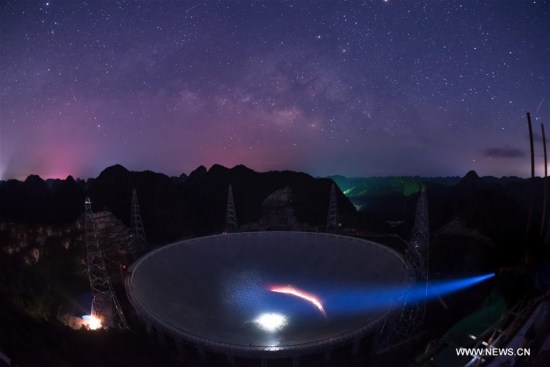
Photo taken on June 27, 2016 shows the Five-hundred-meter Aperture Spherical Telescope (FAST) under the stars in Pingtang County, southwest China's Guizhou Province. The China-based FAST, the world's largest single-dish radio telescope, has identified two pulsars after one year of trial operation, the National Astronomical Observatories of China (NAOC) said on Oct. 10, 2017. (Xinhua/Liu Xu)
After one year of trial operation, China's Five-hundred-meter Aperture Spherical Radio Telescope (FAST), the world's largest single-dish radio telescope, has identified multiple pulsars, the National Astronomical Observatories of China (NAOC) said Tuesday.
It was the first time a radio telescope independently developed by Chinese scientists has found pulsars.
Two of the pulsars, named J1859-01 and J1931-01, are 16,000 light years and 4,100 light years from Earth with rotation periods of 1.83 seconds and 0.59 seconds, respectively.
According to Li Di, chief scientist at the radio astronomy division of the NAOC, the two pulsars were discovered on Aug. 22 and 25 when FAST was drift-scanning the southern galactic plane. The discovery was later confirmed by the Parkes radio telescope in Australia in September.
Li said FAST has already detected dozens of promising pulsar candidates, six of which had been confirmed by international organizations.
Peng Bo, deputy director of the FAST project, said three to five years of trial operation is usually required for a radio telescope as large and complicated as FAST.
"It is truly encouraging to have achieved such results within just one year," said Peng.
Located in a naturally deep and round karst depression in southwest China's Guizhou Province, FAST was completed in September 2016.
Its receiving area is equivalent to about 30 football fields.
Astronomers are able to use FAST to survey hydrogen in the Milky Way and other galaxies, detect thousands of new pulsars and study the origin and evolution of the universe.
Over 2,700 pulsars have been identified since the first one was discovered by British astronomers Jocelyn Bell Burnell and Antony Hewish on Nov. 28, 1967. But almost all of them are within the scope of the Milky Way.
Many scientists expect FAST to be the first telescope to capture a pulsar outside the galaxy.
Technical preparations have been made for FAST to search for pulsars outside the Milky Way as early as next year.
FAST is believed to be the world's most sensitive radio telescope. Engineers have said it is so sensitive it could capture the signal of a cell phone being used on the moon.
Before the completion of the Square Kilometer Array (SKA) telescope, funded by a consortium of countries, FAST will remain the global leader for the next 10 to 20 years.
The telescope is expected to discover twice the number of pulsars currently known and it is highly likely to make breakthroughs in the study of gravitational waves and general relativity theory, said Sun Caihong, its deputy chief technologist.
FAST's other tasks include exploration of interstellar molecules and communication signals, as well as building an accurate picture of the universe.
"FAST is going to become central in developing a new map of our universe that is going to be used for all sorts of science. It will probably be many decades before a better map is created," said Marko Krco, a visiting U.S. astronomer at the NAOC.


















































